#i predicted that skeletons' team color was gonna be orange
Explore tagged Tumblr posts
Text

a sketch i did at like 5am today before i went to sleep coz i knew today had splatoween announcement energy haha im excited
#i mostly posted about this one twitter#but i made different team predictions in my notes and knew they was gonna have a team skeleton & team ghost#i also called it that big man was gonna be ghost FOR THE SOLE REASON that i could see him wearing a fullbody ghostly cloth#AND BOOM THEY DID IT!!!#also in this pic (even tho i associated team skeleton with shiver)#i predicted that skeletons' team color was gonna be orange#ok im done rambling about this lmao#BUT I TOLD MYSELF BACK IN SEPTEMBER IF THEY HAD TEAM SKELETON IM JOINING IT 100%#I'll lose it if frye makes a sans undertale reference in game#like she says: if you underestimate us we'll give you a BAD TIME#idk dawg#/positive connotation#doodle#loafbud#deep cut#splatoween#splatoon#splatoon 3#fanart
45 notes
·
View notes
Text
RWBY and the Philosopher’s Stone
So, I finally watched RWBY after a friend name-dropped several characters and I was like wait... those names are alchemical. I was still pleasantly surprised to find out just how deeply rooted in alchemy the story is, from its characters to its plot structure.
Background: alchemical structure is a type of story structure that focuses on inner transformation via outward obstacles. You can find it in literary traditions across the world, from Moxiang Tongxiu’s novels to A Song of Ice and Fire to Harry Potter to The Witcher to Trollhunters. Carl Jung incorporated it into his psychology. Daoism plays heavily into Chinese alchemy. The Wizard of Oz, one of RWBY’s main inspirations, is a blatant alchemy allegory. It’s everywhere, so it’s not surprising RWBY is drawing heavily on alchemy, but it is neat to see how blatant the references are.
Thematically, the goal of alchemy is a metaphorical philosopher’s stone. The philosopher’s stone, in legend, is said to produce an elixir of eternal life, and to be able to transform “baser” metals into gold.
In stories, when positive, as it usually is, this usually results in a character either overcoming death (see, Harry Potter) and/or transforming the world and others around him (Harry Potter saving his friends, etc.) But the journey from how they get from prima materia (raw material) to the philosopher’s stone? Now that’s the story.
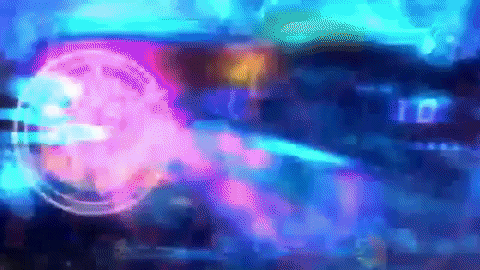
(When reversed, a metaphorical stone results in something that can destroy everything; see: the One Ring, also Salem, because Salem’s whole thing is that she cheapened the process of life and death, while alchemy states that death is a necessary part of achieving life.)
So, mostly I’m gonna talk about the symbolism I’ve seen so far and make some predictions for what’s likely to happen next in the story, and for the characters.
Each of the four main characters has a name that corresponds to one of the four phases of the Magnum Opus. “Blake Belladonna” refers to the nigredo, or black stage; “Weiss Schnee” to the albedo, or white stage; “Yang Xiao Long” to the citrinitas or yellow phase, and “Ruby Rose” to the final stage, rubedo, or red (Ruby’s name is quite literally taken from that stage). Naming them for these stages shows a dual purpose: while Ruby is the central character, she needs her team around her, and Team RWBY will save the world together. Team JNR is also a part of the stages, but I’ll get to what they represent later on.
Jung associated each of the major stages with a major archetype. The major stages can be further broken up into a total of seven or twelve or even fourteen stages. Most commonly you’ll see George Ripley’s Twelve Gates referenced, and I believe that’s what RWBY is referencing as well since its allusions are pretty perfect. The "gates” or stages also sometimes overlap, especially when different characters might be at different stages.
Nigredo: Seasons 1-3
Alchemy begins by gathering the prima materia, or raw material. The characters assembling in season 1 is more of the gathering than the actual transformative process. But once we hit season 2, we dive straight into the process.
Calcination occurs during the climax of season 2, during the fight on the train. Season 3 contains dissolution, or the washing of impurities through the exposure of certain secrets (like the fall maiden) as well as the literal dissolution of Beacon Academy, and separation (the end of the season, when Team RWBY is scattered).
Narratively, Jung associated nigredo with the shadow, with someone’s dark night of the soul, their low point. In historical artistic depictions, often part of nigredo is dismemberment... which happens to Yang when she saves Blake from Adam. See, Splendor Solis:
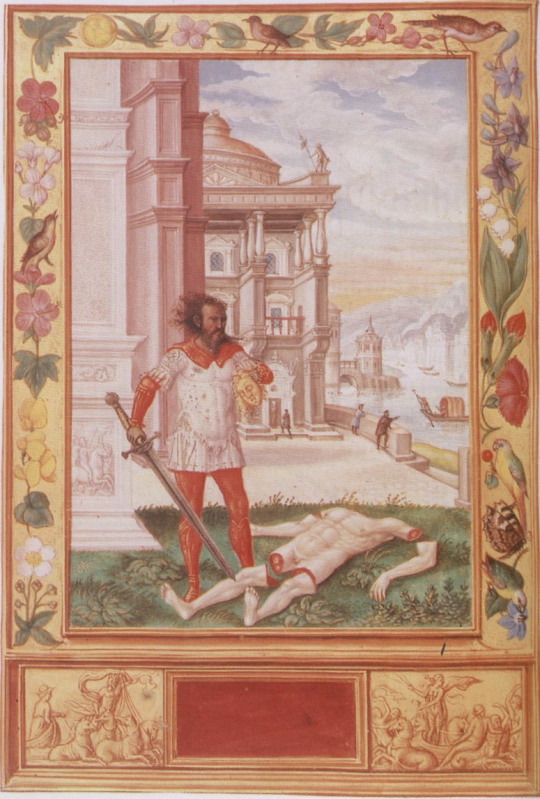
The goal of the shadow is that it should be integrated with, accepted, rather than denied. Facing the shadow is a necessary part of growth and ultimate transformation... and the point is, through facing the shadow, hope and light come.
Peacock’s Tail: Seasons 4-5
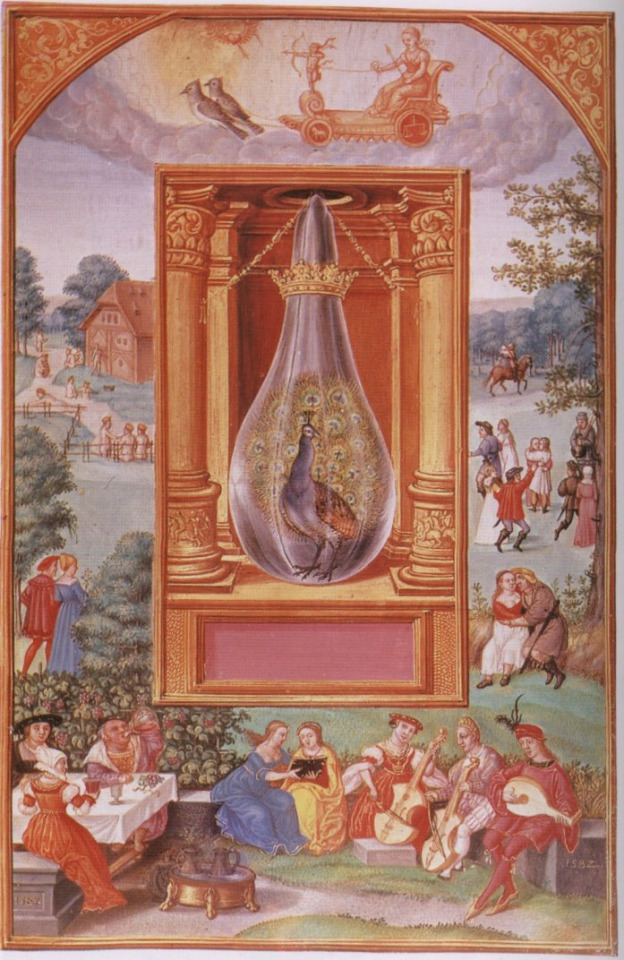
Okay, I lied, there are sometimes five phases in alchemy. At the very end of nigredo, just before albedo, there is sometimes a flash of light, of rainbows and colors, that give hope. It’s not quite a phase, more of a moment, but it’s referred to as the peacock’s tail. While this is less plot-related, it does make sense that this is the point in the story where Team RJNR is formed. Why? Because look at their colors:
Ruby: red, black
Jaune: yellow, blue
Ren: green, purple
Nora: white, pink, orange
Between them we’ve pretty much got the full rainbow.
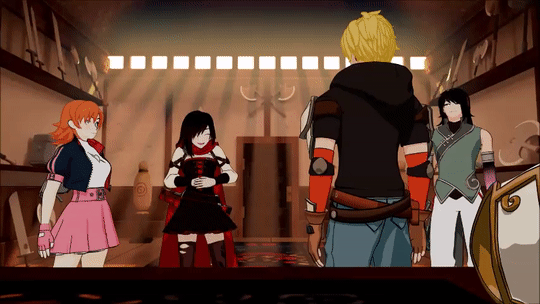
We also have, in Blake’s arc, the introduction of Ilia Amitola, whose last name is the Souix word for “rainbow.”
Albedo: Seasons 5-7
Albedo is associated with the anima or animus, or the part of ourselves that we are lacking (it’s generally gendered as the male within a female and the female within a male, but please understand he’s not talking literally and more in terms of traditional qualities ascribed as feminine or masculine that we may repress), which more than fits the fact that this stage begins while team RJNR is literally wandering around a continent called Anima.
Conjunction is a term in which all the separated parts that can be salvaged from the Nigredo come together. Obviously the main incident for this is the fight at the end of volume 5, but I’d argue it overlaps a bit with volume 4 and even with separation.
The characters are only able to come together again once they’ve accepted aspects of their shadows. Yang deals with hers in Raven and Blake with the White Fang. Nora and Ren’s fight at their home village represents them dealing with their shadow as well, and also relates to conjunction because conjunction is the stage where the first chemical wedding comes into play. A chemical wedding is the joining of alchemical partners, and while I’ll probably discuss ships in another post (there’s a lot of set up alchemy-wise), I’ll just reference the obvious one here:
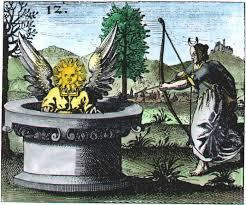
The fountain image and a person shooting arrows is some pretty uncannily similar imagery to the fight at Nora and Ren’s home village.
Next up in albedo is putrefication (focus on death and rotting). We see this with the encounter with the Apathy, who look like skeletons, cause death, etc. We’re also introduced to Maria Calaveras, aka the Grimm Reaper. (Her last name also means “skull” aka the white results of putrefication).

Congelation requires a lot of water, and we see this in the focus on Atlas, wherein snow (water) is everywhere. The point of congelation is to separate the thin from the thick, the latter of which will of course become the Philosopher’s Stone. We see this through Team RWBY’s break with the Ace-Ops (aka the Aesops), whose simplistic morality and rule-following are not going to bring about character growth or eternal life.
Citrinitas: Volume 7-?
Citrinitas focuses on the light, or fire. That immediately after congelation, a giant whale brimming with yellow appears in the white-colored Atlas is not a coincidence. Citrinitas is associated with the sage or the wise old man/woman, so Maria and Pietro fill this role.

The first stage of citrinitas is cibation, which involves feeding with fresh material. I’d actually say that it seems quite possible cibation overlaps with congelation, in that there is a focus on food and on training with the Ace-Ops early in Volume 7. The next phases are sublimation and fermentation. I can see potential for sublimation in that it essentially is when solid becomes air (think of the setting of Atlas), but it’s too soon to say what this means for the plot.
Fermentation, though... well, things will get worse before they get better. :’)
Rubedo:
Finally, Rubedo is associated with the fully individualized self. We can assume each of the main seven will come into their own, confident of whom they are. Oscar should, as well, and probably will have fully control over his body by the end (ie Oz will likely... find rest or whatever).
The stages of rubedo are exaltation (the creation of the stone after two contraries meet), multiplication (the stones’ properties increase), and projection (the stone’s abilities are projected over the entire world, aka presumably RWBY will save the world).
The most common way to display multiplication is through, well, a lot of couplings. It’s why the main characters ending single seems extremely unlikely to me. Even if it seems a fairy tale ending, well.... *gestures to everything about RWBY being inspired by fairy tales* Fairy tales were also often alchemy based. But ships will get their own meta, because I actually don’t really ship much besides Renora and am for once not super invested in anything, but I can see the set-up for four or five ships.
I also want to highlight the other symbolic names that stood out to me:

Ironwood. While I know Ironwood references the Tin Man in The Wizard of Oz (tin being one of seven metals associated with alchemy), his name also references a second metal: Iron. Tin and Iron are the two of the three basest metals in alchemy (the other is lead). Iron in particular is ruled by Mars, the god of war, meaning it is associated with violence. It’s not a coincidence that pretty much from the second Ironwood is introduced, the concept of war comes up, and his entire character has gone on to be the embodiment of the military and violence.
Tai Xiao Long. His name literally means “sun,” and Ruby’s mother is defined by her silver eyes (silver being a color traditionally associated with the moon). Ruby is thus considered the child of the Solar King and Lunar Queen, two mythical alchemical figures who together create the “Philosophical Child,” or the personified philosopher’s stone.

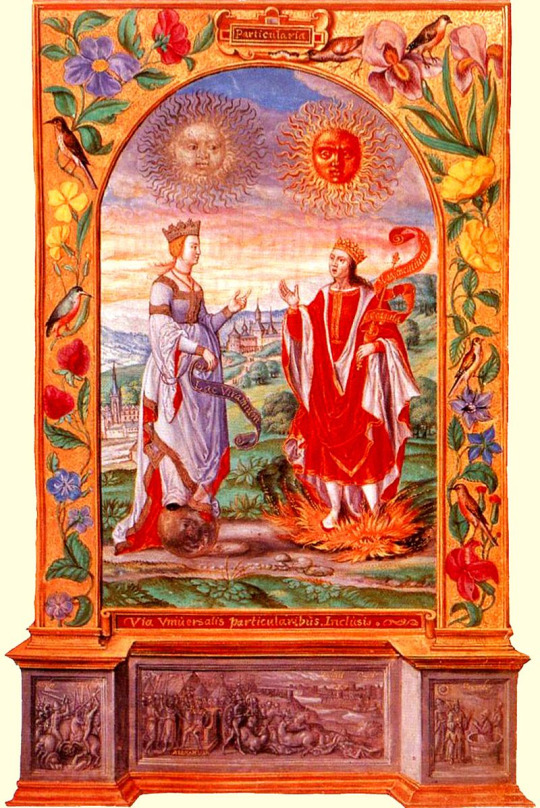
Pietro Polendina: his name literally means “stone,” and Penny is his philosopher’s stone. Penny is arguably a reference to copper, another of the seven metals, as copper references compassion and love, which seems like Penny to me.
Qrow and Raven Branwen: crows and ravens are symbolic of nigredo, or the black phase; death, decay, etc. However, within the story I think Qrow and Raven fulfill this role as the Jungian shadows of hunters as a whole and of Yang.
Sun Wukong: obviously a reference to the sun.
Emerald Sustrai: Emerald is a reference to the Emerald Tablet, which in alchemical lore is a tablet containing the secrets of alchemy, as written down by Hermes (in legend). Hermes is, of course, Mercury. Everything about alchemy stems from the Emerald Tablet, so Emerald should be important. In addition, green is the color of the prima materia, so it references Emerald’s arc in being shaped and molded by Cinder.

Mercury Black: Mercury as the mythological god is the legendary founder of alchemy, so like, he’s important. Mercury is also the third most important metal in alchemy, after gold and silver. It is necessary to achieving the philosopher’s stone so, like Emerald, Mercury is probably important. Mercury is of particular note because mercurial characters are common in alchemical literature: they make stuff happen. Think of Mercutio in Romeo and Juliet, for example. Mercury transcends death symbolically (you can see the roots of this in Mercury’s backstory with his assassin father): it is difficult to pin down and can quickly shift from liquid to solid. Thus, in alchemy, mercury can shift between life and death.
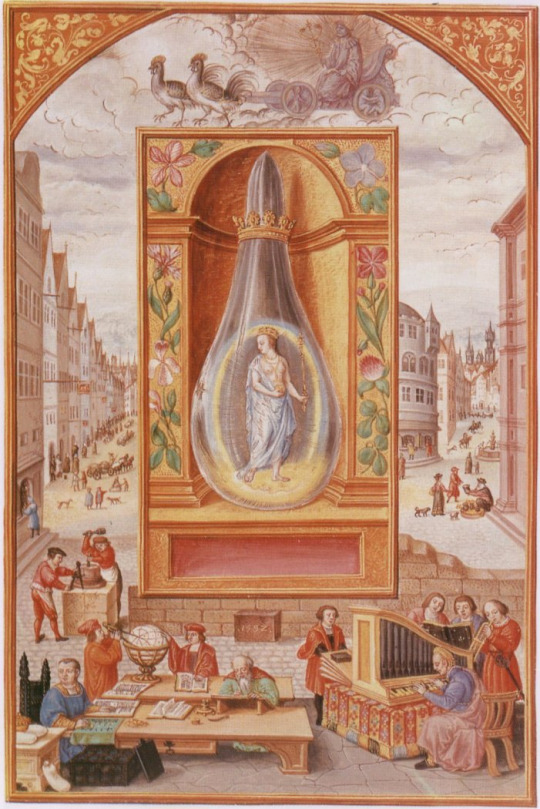
Mercury is also a noted servant of the white queen. I initially thought this a surface reference to Salem’s appearance, and it might be, but Salem is more associated with a black queen in the recurring chess motif, and I don’t see Mercury staying on her side (mercury isn’t fixed, after all; that’s its central tenet), so I kind of wonder if the “white queen” will be later revealed. Or maybe it just is a surface mention.
#rwby#rwby theory#rwby meta#rwby volume eight#rwby vol 8#ruby rose#weiss schnee#yang xiao long#blake belladonna#salem#tai xiao long#jaune arc#nora valkyrie#lie ren#mercury black#emerald sustrai#qrow branwen#penny polendina#pietro polendina#alchemy#jung#raven branwen#james ironwood
360 notes
·
View notes